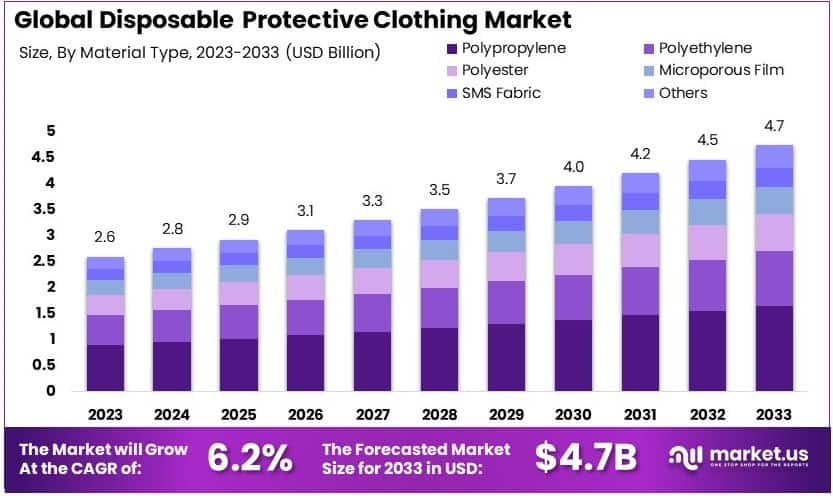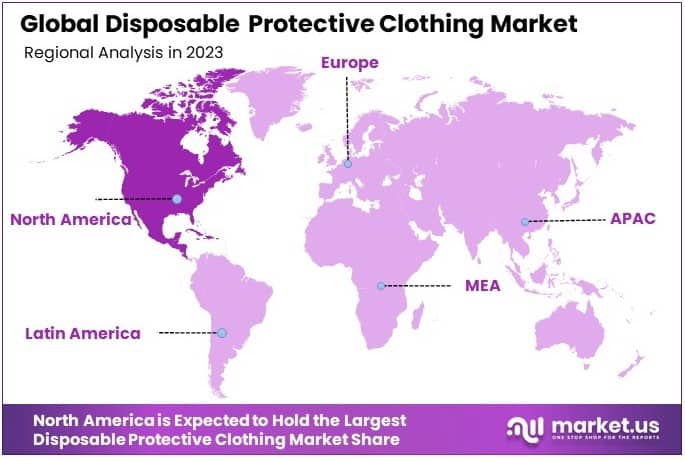Table of Contents
Introduction
New York, NY – April 10, 2025 – The Global Disposable Protective Clothing Market is projected to reach approximately USD 4.7 billion by 2033, up from an estimated USD 2.6 billion in 2023. This growth is anticipated to occur at a compound annual growth rate (CAGR) of 6.2% during the forecast period spanning from 2024 to 2033.
Disposable protective clothing refers to single-use garments designed to protect individuals from hazardous substances, including chemicals, infectious agents, and particulates, across a range of industrial and medical environments. These garments comprising coveralls, lab coats, gowns, and aprons are manufactured using materials such as polyethylene, polypropylene, and spunbond-meltblown-spunbond (SMS) fabric, offering essential barrier protection without the need for cleaning or reuse.
The disposable protective clothing market represents the ecosystem of manufacturers, distributors, and end-users engaged in the supply and application of such apparel in sectors like healthcare, pharmaceuticals, chemicals, construction, and oil & gas. The market is witnessing steady growth, primarily driven by stringent regulations surrounding occupational health and safety, as well as increased employer focus on minimizing workplace hazards. The demand is further reinforced by the growing scale of industrial operations and the rising frequency of hazardous tasks requiring single-use protective solutions. Heightened awareness of personal protective equipment (PPE) as a preventive measure has also fueled consistent adoption, particularly in environments where cross-contamination and chemical exposure pose critical risks.
Technological advancements in breathable and lightweight protective fabrics are expanding product availability, enhancing wearer comfort, and supporting broader application across new industry verticals. The Asia-Pacific region, with its rapidly growing industrial and healthcare infrastructure, presents a substantial growth opportunity due to the increasing adoption of safety standards and investments in protective equipment. Overall, the disposable protective clothing market is expected to expand significantly, supported by regulatory compliance, industrial safety awareness, material innovation, and emerging economies prioritizing occupational health standards.

Key Takeaways
- The Disposable Protective Clothing Market was valued at USD 2.6 billion in 2023 and is projected to reach USD 4.7 billion by 2033, expanding at a compound annual growth rate (CAGR) of 6.2% during the forecast period.
- In 2023, coveralls accounted for the largest share of 40% in the product type segment, primarily due to their ability to provide full-body protection and their adaptability across various hazardous environments.
- Polypropylene held the highest share of 35% in the material type segment in 2023, attributed to its lightweight structure, cost-effectiveness, and effective barrier against contaminants.
- The healthcare sector dominated the end-use industry segment with a 30% share in 2023, driven by stringent infection control protocols and increased usage of disposable protective clothing in medical settings.
- North America emerged as the leading regional market in 2023, supported by a well-established healthcare infrastructure, strict regulatory standards, and high awareness regarding occupational safety.
Request A Sample Copy Of This Report at https://market.us/report/disposable-protective-clothing-market/request-sample/
Report Scope
| Report Features | Description |
|---|---|
| Market Value (2023) | USD 2.6 Billion |
| Forecast Revenue (2033) | USD 4.7 Billion |
| CAGR (2024-2033) | 6.2% |
| Segments Covered | By Product Type (Coveralls, Gowns, Lab Coats, Aprons, Sleeves, Shoe Covers, Bouffant Caps, Others), By Material Type (Polyethylene, Polypropylene, Polyester, Microporous Film, SMS (Spunbond/Meltblown/Spunbond) Fabric, Others), By End-Use Industry (Healthcare, Manufacturing, Oil and Gas, Chemical Processing, Construction, Food Processing, Agriculture, Pharmaceuticals, Others) |
| Competitive Landscape | DuPont de Nemours, Inc., Kimberly-Clark Corporation, Lakeland Industries, Inc., 3M Company, Ansell Limited, Alpha Pro Tech, Ltd., Cardinal Health, Inc., Uvex Safety Group, Protective Industrial Products (PIP), Honeywell International Inc., International Enviroguard, Delta Plus Group, Tronex International, Inc., Medline Industries, Inc., Sioen Industries NV |
Emerging Trends
- Adoption of Eco-Friendly Materials: Manufacturers are increasingly utilizing biodegradable and recyclable materials to produce disposable protective clothing, addressing environmental concerns associated with disposal.
- Integration of Advanced Functionalities: Protective garments are being enhanced with features such as antimicrobial properties, flame resistance, and moisture-wicking capabilities to improve safety and comfort.
- Emphasis on Comfort and Breathability: There is a growing demand for protective clothing made from materials that offer improved comfort and breathability, facilitating prolonged usage without discomfort.
- Expansion of E-Commerce Platforms: The rise of online retail channels has made disposable protective clothing more accessible, allowing consumers to compare products and prices conveniently.
- Focus on Sustainability: Companies are striving to develop eco-friendly disposable protective clothing solutions, addressing environmental concerns associated with non-biodegradable materials.
Top Use Cases
- Healthcare Sector: Used extensively by medical professionals to prevent contamination and maintain hygiene standards in hospitals and clinics.
- Manufacturing Industry: Protects workers from exposure to hazardous materials and processes, ensuring compliance with safety regulations.
- Construction Sites: Provides protection against dust, debris, and other environmental hazards encountered during construction activities.
- Oil and Gas Industry: Guards against chemical spills, fires, and other occupational hazards inherent in oil and gas operations.
- Defense and Public Safety: Utilized by military and emergency response personnel to protect against biological and chemical threats.
Major Challenges
- Environmental Impact: Concerns regarding the disposal of non-biodegradable protective clothing contribute to environmental pollution.
- Cost Constraints: High costs associated with advanced protective clothing can limit adoption, especially in cost-sensitive industries.
- Comfort and Fit Issues: Ensuring that protective clothing is comfortable and fits well can be challenging, affecting user compliance.
- Regulatory Compliance: Meeting diverse and stringent safety standards across different regions can be complex for manufacturers.
- Competition from Reusable Alternatives: The availability of reusable protective clothing poses a challenge to the disposable segment.
Top Opportunities
- Product Innovation: Developing protective clothing with enhanced features such as improved comfort, durability, and environmental friendliness can attract a broader customer base.
- Emerging Markets: Expanding into developing regions with growing industrial sectors presents significant growth opportunities.
- Sustainable Solutions: Investing in eco-friendly materials and production processes can address environmental concerns and appeal to environmentally conscious consumers.
- E-Commerce Expansion: Leveraging online retail platforms can enhance market reach and accessibility to a wider customer base.
- Collaborations and Partnerships: Forming strategic alliances with other companies can facilitate knowledge sharing, technology transfer, and market expansion initiatives.
Key Player Analysis
The global Disposable Protective Clothing Market in 2024 is characterized by intense competition among well-established players who are focusing on innovation, strategic partnerships, and regional expansion. DuPont de Nemours, Inc. continues to lead through its advanced material technologies and diversified product offerings tailored for high-risk environments. Kimberly-Clark Corporation and 3M Company are leveraging their strong distribution networks and R&D capabilities to address growing demand across healthcare and industrial sectors.
Lakeland Industries, Inc. and Ansell Limited remain pivotal in supplying cost-effective yet high-performance apparel, particularly for emerging markets. Alpha Pro Tech, Ltd. and Tronex International, Inc. are enhancing their global reach through agile manufacturing and supply chain models. Cardinal Health, Inc. and Medline Industries, Inc. are strengthening their foothold in healthcare through integrated solutions and bulk supply contracts. Meanwhile, European companies such as Uvex Safety Group, Delta Plus Group, and Sioen Industries NV are driving innovation in comfort and sustainability. Honeywell International Inc., Protective Industrial Products (PIP), and International Enviroguard are expanding their protective clothing portfolios to cater to evolving regulatory standards and end-user needs.
Purchase The Full Report Now at https://market.us/purchase-report/?report_id=135113
Top Companies in the Market
- DuPont de Nemours, Inc.
- Kimberly-Clark Corporation
- Lakeland Industries, Inc.
- 3M Company
- Ansell Limited
- Alpha Pro Tech, Ltd.
- Cardinal Health, Inc.
- Uvex Safety Group
- Protective Industrial Products (PIP)
- Honeywell International Inc.
- International Enviroguard
- Delta Plus Group
- Tronex International, Inc.
- Medline Industries, Inc.
- Sioen Industries NV
Regional Analysis
North America Leads the Disposable Protective Clothing Market with the Largest Market Share of 35.2% in 2024
In 2024, North America has emerged as the leading regional market for disposable protective clothing, accounting for the largest share of 35.2% of the global revenue. This dominance can be attributed to the region’s well-established industrial infrastructure, stringent regulatory frameworks for worker safety, and extensive adoption across industries such as healthcare, manufacturing, chemical processing, and oil & gas. The United States, in particular, serves as the core growth engine due to significant investment in occupational safety and health standards enforced by agencies such as OSHA (Occupational Safety and Health Administration). Additionally, the rising frequency of public health emergencies and increasing focus on infection control measures have contributed to the sustained demand for high-quality protective apparel across medical and emergency response sectors.

Recent Developments
- In 2024, Medline announced the completion of its acquisition of Ecolab’s global surgical solutions business, including the Microtek™ product line. This move strengthens Medline’s product range and adds new capabilities to serve hospitals and surgical centers worldwide. The company aims to deliver better value through innovation and improved supply chain support with this addition.
- In 2024, Winner Medical confirmed the acquisition of a 75.2% stake in Global Resources International (GRI) for approximately USD 120 million. This marks Winner Medical’s entry into the global market through a major overseas investment. The deal is expected to boost international operations and increase supply chain efficiency across the U.S. and Europe.
- In 2024, Ansell revealed its agreement to acquire Kimberly-Clark’s Personal Protective Equipment (KCPPE) business for USD 640 million. The transaction is planned to close by September 2024, pending regulatory clearance. The acquisition will help Ansell expand its safety product portfolio and support its long-term market strategy.
- In 2024, DuPont Personal Protection announced the winners of its 10th Protection Innovation Award. The award celebrates outstanding designs in protective gloves and sleeves using Kevlar® or Nomex® materials. These innovations focus on both safety and wearer comfort, showcasing DuPont’s leadership in protective fiber technology.
Conclusion
The disposable protective clothing market is poised for substantial growth, driven by stringent safety regulations, increasing awareness of occupational hazards, and advancements in material technology that enhance wearer comfort and protection. The healthcare sector’s emphasis on infection control, coupled with the expansion of industries such as manufacturing and construction, further fuels demand for single-use protective apparel. North America maintains a leading position in this market, attributed to its robust industrial base and rigorous enforcement of safety standards. However, regions like Asia-Pacific are rapidly emerging as significant contributors, propelled by industrialization and heightened safety awareness. Despite challenges related to environmental concerns and competition from reusable alternatives, the market presents opportunities through innovations in sustainable materials and the integration of advanced functionalities. Strategic acquisitions, such as Ansell’s procurement of Kimberly-Clark’s personal protective equipment division, underscore the dynamic nature of the market and the ongoing efforts by key players to expand their product portfolios and global reach.
Discuss Your Needs With Our Analyst
Please share your requirements with more details so our analyst can check if they can solve your problem(s)





